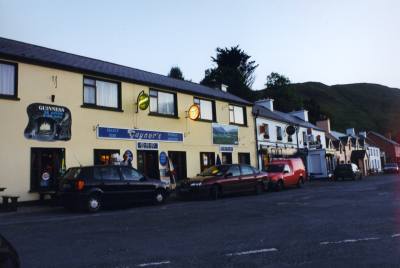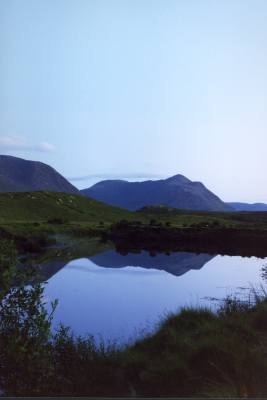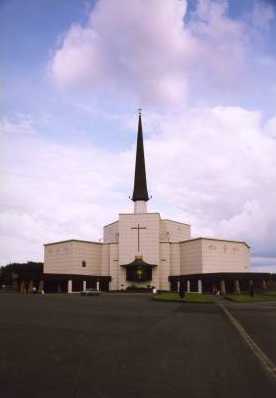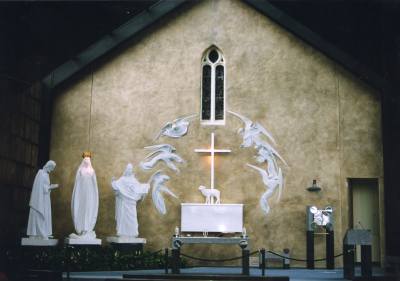
Mayo:
‘A Driver's Dream’.
Just what is so appealing about driving through Mayo?
As any visitor will tell you, driving through Mayo is simply a joy – and it's not just because it’s a traffic-jam free zone! Whilst touring, one can view the county’s majestic cliffs, heather-clad hills, stone-walled pastures and twinkling lakes – and that’s just in one afternoon!
Apart from its breathtaking beauty, the one thing that sets Mayo apart from everywhere else is its genuinely warm people. Even whilst driving, everyone salutes in welcome: The farmer on his land looks up to raise a hand, the children on their bicycles beam, and as you pass house gates, conversations pause as heads nod and hands wave in greeting.
Why not follow the suggested drives below for days of activity!
Or alternatively click here to see what else Mayo has to offer.
THE WEST MAYO/NORTH CONNEMARA DRIVE.
Take the N60 (also called the N5) from Castlebar to Westport. On the outskirts of Westport is Westport House, a fine Georgian mansion that was the home of the marquees of Sligo. Designed by the German architect Richard Cassels in 1730 and later modified by Wyatt, it houses many fine antiques. Italian craftsmen were brought here specifically for the purpose of building its attractive marble staircase. Westport House is open from April to September. The childrens zoo and playground is open from June to September.
1.
2. Then leave Westport on the R335 road for Louisburg. This route gives you views of Clew Bay and its many islands. After 8kms you will come to the base of Croagh Patrick: Ireland’s holy mountain. Its 2,510 foot summit offers an inspiring view of the island dotted Clew Bay. St Patrick is said to have spent forty days and nights in prayer and fasting on the summit in 441, and each year people make pilgrimage in his honour. A ten minute walk to the first statue is recommended to get a flavour of the pilgrimage. It is also interesting to note that the ruins of the 14th century Augustinian Murrisk Abbey lies at the base of the mountain.
3. When you reach Louisburg you will find a quaint village guarding the mouth of the river Bunmore. Why not take a break from driving at this stage and stretch your legs on one of the many blue flag beaches in this area? See Visit a Blue Flag Beach for more details.
4. From Louisburg, take the R335 road for Leenane. This is a desolate but scenic route with the Sheefry Hills to your left and Mweelrea Mountains to your right. It was at Delphi lodge near the outlet of Doolough that Prince Charles spent his recent fishing vacation in Ireland.
Further on the road leads to the northern shores of Killary Harbour (Irelands only natural fjord), and then onward to the lovely waterfall of ‘Aasleagh Falls’. This waterfall featured in the film ‘The Field’.

Turning right after Aasleagh will bring you to the picturesque village of Leenane. This is a popular stop for a cup of tea before continuing (don’t be alarmed if you see ‘tea’ being drunk from a pint glass with a frothy head in this lovely village!).

5. After Leenane you can take the N59 then the N60 (the most direct route) back to Castlebar through the impressive Erriff Valley or …
IF YOU FEEL LIKE A LONGER DRIVE
6. Continue on the R336 through the beautiful Joyce Country that covers much of the Maam Valley and North Connemara. On this route you will experience Connemara at its best, where the infinitely changing patterns in the sky are as much a key part of the vistas as the primordial mountains, rivers and lakes.
7. The R345 will take you to Cong, and on the way you can marvel at some of the most spectacular lake scenery in Ireland.
In Cong are the ruins of the 12th century Cong Abbey and the luxury hotel ‘Ashford Castle’. Cong Abbey was once an Augustinian Abbey founded by Turlough O’Connor, High King of Ireland. It is considered one of the finest examples of early architecture in Ireland.
Ashford Castle and its environs are famous for the setting of the Irish-American movie ‘The Quiet Man’. The building is impressive, and there are miles of landscape walks through the grounds of the castle. A cover charge to enter the grounds may be requested at the entrances.
By now taking the R334 to Ballinrobe, and then the N84 you will be back in Castlebar in no time! However…
IF YOU STILL WANT MORE
Take the route north passing through Clonbur and Finney and onward to Tourmakeady passing along the beautiful western shores of Lough Mask. A few miles past Tourmakeady take the turn for Partry and Castlebar (all signposted). At the crossroads of Ballintubber take the road to the right which leads you to Ballintubber Abbey Founded in 1216 by King Cathal O’Connor, the abbey consists of a cruciform church with nave transepts and choir. A visit to the monastic buildings and grounds is highly recommended. The abbey is open all year.
BACK TO BASE!
Return to the N84 and continue north to Castlebar by which time you will have developed a healthy appetite!
THE ACHILL ISLAND DRIVE.
(Castlebar – Newport – Mulranny – Achill)
1. Leave Castlebar on the R311 road for Newport. On the left, two miles from Newport town lies the ‘Leg of Mutton’ lake: this was the location of Princess Grace Kelly’s ancestral home.
2. As you enter Newport you will see a beautiful cut-stone, seven arch viaduct, which dates back to 1892. The railway line once ran from here to Achill Island. After Newport, take the Achill road.
3. A short distance out you will see a sign to the right, this brings you to the beautiful lakes of Furnace and Lough Feeagh. Between these two lakes is the Salmon Research Fishing Agency Centre. This region is a little remote but very scenic, and is well worth a visit if you have a little time to spare!
4. Now return to the N59 in the direction of Achill. You will soon come to a sign for Burnshode Abbey. Why not get out of the car at this stage of your travels and have a proper look at this ruin of a 15th century Dominican Friary!
5. Onward to the village of Mulranny!
This region is renown for its lushness, it also boasts of a beautiful beach which can be accessed from the town via a walkway. After Mulranny village take the signposted Atlantic Drive to Achill Sound.
6. Achill Island is the largest of Irelands offshore islands (24km long), now clinging to the mainland by a bridge. This rock-strewn isle of wild beauty, trimmed with sandy coves, is yours to explore, thanks to the marvellous sculpting of the Ice Age! Driving through Achill certainly is an experience to remember!
At Achill Sound you may follow the main road to Keel or take the scenic Atlantic drive. The Atlantic drive offers the visitor spectacular scenery (but is not recommended for the very faint hearted!). The Atlantic drive will bring you past Granuaile’s castle, which was once a watchtower for the famous 16th century pirate queen of Connaught. This route passes the spectacular Cathedral Rocks: water-carved cliffs that somewhat resemble a Gothic cathedral rising from the depths of the Atlantic Ocean.
7. Although Ireland boasts countless, glorious strands, one of the most superb beaches is Tramore, found in Keel. Tramore is 5kms of sandy paradise nestled under the shadow of the impressive Minawn Cliffs, and a walk here is highly recommended!
After Keel there is much to explore in Achill Island. You may wish to visit ‘the forgotten village’, climb one of its three mountains, drive to the beautiful little lake of Lough Accorymore or visit the secluded little beach at Keem Bay.
To return to Castlebar follow the direct route to Mulranny through Newport to Castlebar.
THE LAKES DRIVE.
1.
Take the N5 road from Castlebar and turn left at Ballavary, then take the N26 heading for Straide. The village is the birth and burial place of the famous Michael Davitt (1846-1906), who was fundamental in the establishment of the Land League in the 1800s, whose primary aim was to fight for the rights of downtrodden Irish tenants. The village is home to a museum dedicated to Davitts memory, and to the outstanding work done by the Land League.2.
Next continue on the N58 to Foxford, a quiet town on the Moy River, sheltered by the Ox Mountain range on the north-east. While you are here why not visit the Foxford Woollen Mills Visitors’ Centre, which relives the legendary story of a spirited and resourceful nun, Mother Agnes Morrogh-Bernard who established the Foxford Woollen Mills in 1892. It was thanks to her that the mills became a roaring success and the town flourished around it. The town is now known world-wide for producing top quality rugs, tweed, and blankets. An audio-visual history of the woollen mills is given in addition to a guided tour, where visitors can watch the skilled Foxford Woollen Mills craftspeople at work!There is a shop located within the centre selling mainly tweed garments and hats.
3.
As you continue on the N57 road you will come to the town of Ballina.This town is the birthplace of former Irish President and current U.N. High Commissioner, Mary Robinson. This area is also known as one of Europe's premier angling centres, being surrounded by the bountiful river Moy and unpolluted sea waters. Jack Charlton, a keen angler and the former Irish soccer team manger owns a holiday home in the area.
4.
Continue west from Ballina, taking the N59 towards Crossmolina. You now have the opportunity to see Abbeytown Abbey and Castle Dee, which are among the many ruins near the town.Next take the R310 southward, and you will be able to see Enniscoe House, situated just 3km from the town of Crossmolina. Here you can avail of The North Mayo Family History Centre and Heritage Centre which both offer a genealogical service.
5.
Continue driving on to Pontoon via the R315. On your journey you will see the idyllic, gleaming waters of Lough Conn. It is little surprise that there is a marvellous angling centre here, situated between Lough Conn and Lough Cullin. There are several strands on Lough Cullin, and the area also boasts many leafy laneways and lakeshore walks – the perfect place to leave the car and get some fresh air!6.
The drive ends by following the R310 from Pontoon to your second home, Castlebar!
DRIVE TO KNOCK SHRINE AND FOLK MUSEUM.

1.
Take the N 60 to Claremorris town, then take the N17 to Knock village and Shrine.Knock Shrine is one of the most popular apparition shrines in Europe, it is visited annually by hundreds of thousands of pilgrims who come to give devotion to ‘Our Lady’.
2.
Knock Folk Museum is located in Knock Shrine grounds, just south of the Basilica. If you are interested in the background to the story of the Knock Apparition of 1879 then the Folk Museum is the perfect place to spend an afternoon!

Witness testimonies, contemporary accounts as well as details of cures are all on display. A special place is given in the museum to Msgr. James Horan, a name synonymous with the area. There are also some very interesting folk exhibits on display including modes of transport from the pony and trap to the penny farthing bicycle, and a thatched cottage, actually built inside the museum, with an authentic looking open fire, dresser, hag bed, half-door and an original curragh! In addition the Museum is home to a number of temporary exhibitions during the summer season, each exemplifying the wealth of folklore and tradition that is found in the West of Ireland.
3.
Return to Castlebar on the same route.Open daily May – October.
For further information on mass, confession and vigil times contact (094) 88100 or Fax (094) 88295.